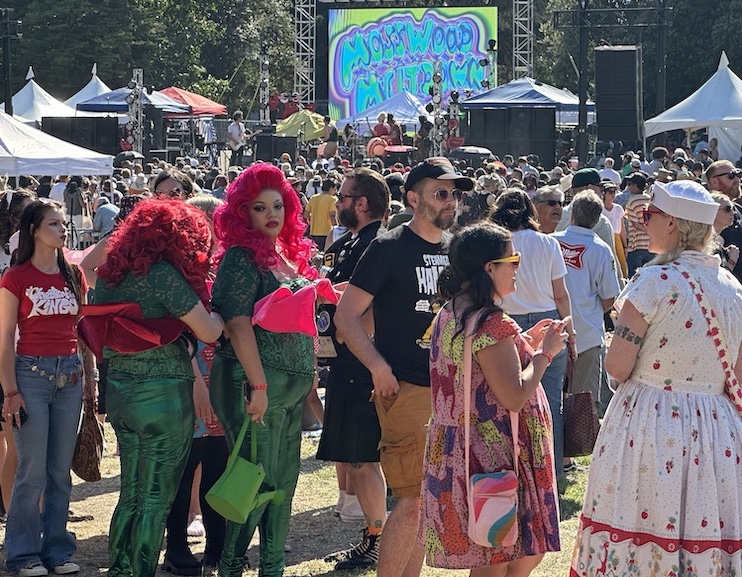
Garage rock has its weekend in the sun during Mosswood Meltdown, presented by Total Trash Productions and hosted by cult classic filmmaker John Waters. Festival-goers dust off old indie rock t-shirts and their best trashy costumes as original punk rockers like the B-52’s or Devo join cult favorites like the Mummies for a takeover of Mosswood Park. Photo by Marlene Goldman
Towering above Uptown Oakland’s Broadway corridor, an Art Deco masterpiece still holds its head high nearly a century after its grand debut. The Paramount Theatre, now a National Historic Landmark, was built as a movie house with intricate decor to rival any theater in America.
The majestic lobby conjures a South American jungle, with terra-cotta pillars representing tree trunks and a green ceiling reflecting a forest canopy. The centerpiece is an almost 35-foot-tall illuminated glass Fountain of Light proclaiming Paramount’s slogan, “Always the Best Show in Town.”
On a recent two-hour public tour of the theater, more than 50 people learned details of its design and its turbulent history. The Paramount opened in 1931 with a 16-piece orchestra for its films. It closed a year later due to costs, only to reopen a year later sans orchestra.
It was a prominent movie palace until 1970, when it fell into disrepair. Thanks to a new owner, the Oakland Symphony Orchestra, it was painstakingly restored in the early 1970s. But in 1975, the orchestra sold the theater to the city for $1 in exchange for 40 years of free rent. Today, it’s once again a bright spot for live performances.
In many ways the ebbs and flows of the Paramount’s past mirror Oakland’s triumphs and struggles, from its early 20th century glory years, including a bustling jazz and blues scene that earned West Oakland the moniker Harlem of the West, to decades of political upheavals and economic and social challenges.
Pre-pandemic, Oakland sat alongside destinations like Oman, Greenland, and the Peruvian Amazon as one of National Geographic Traveler’s most exciting destinations. The publication prioritized Oakland as a must-see city in 2019 for its cultural diversity. For a time, even San Francisco elites moved there seeking its “hipster” vibe and cheaper residential real estate.
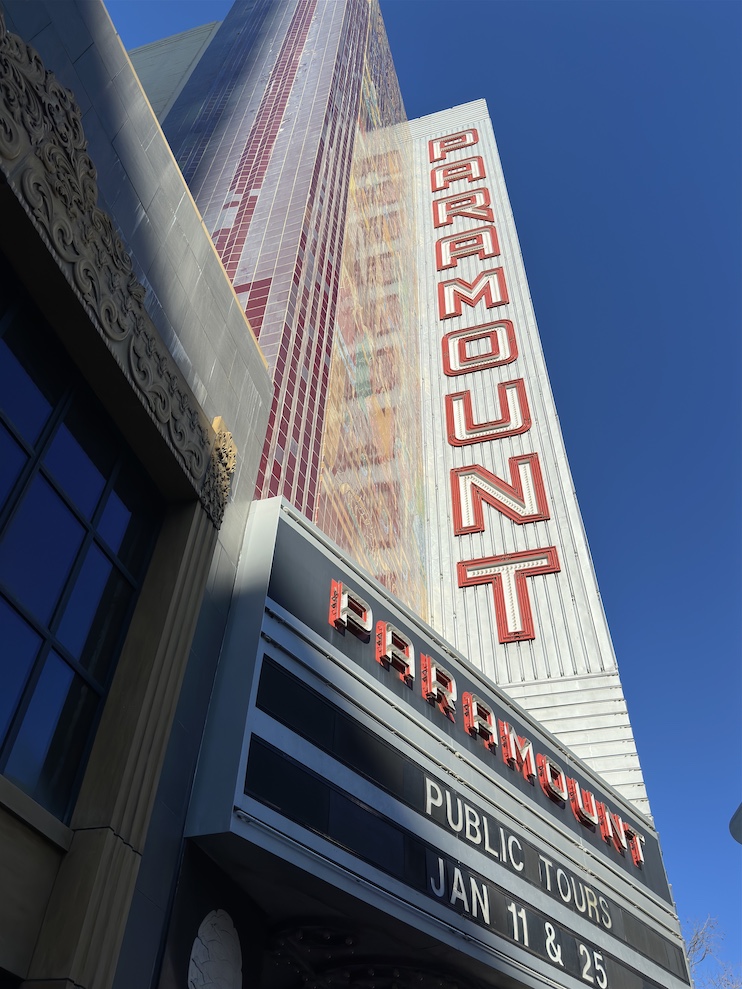
Home of the Oakland Symphony and Oakland Ballet, the Paramount Theatre also hosts world-class music and comedy and is one of the venues presenting the Bay Area’s MPSF Speaker Series for everyone from Joe Montana to Stacey Abrams. Photo by Marlene Goldman
But with the pandemic came massive increases in violent crime, car theft and smash-and-grab retail thievery. By the end of 2023, homicides exceeded 100, robberies were up 38%, while vehicle theft surged 45%.
“What’s happening in this beautiful city is alarming and unacceptable,” said California Governor Gavin Newsom at the start of 2024. “I’m sending the California Highway Patrol to assist local efforts to restore a sense of safety.” Newsom’s campaign increased the police presence in Oakland and the East Bay by 900%.
Voters in November recalled Oakland mayor Sheng Thao and Alameda County District Attorney Pamela Price after the Oakland branch of the National Association for the Advancement of Colored People ridiculed them in a public letter for failed progressive policies that allowed street crime to flourish. “Oakland residents are sick and tired of our intolerable public safety crisis that overwhelmingly impacts minority communities.”
Despite increased law enforcement, crime still occurs. Recently, 40 bronze plaques from the Oakland Blues Walk of Fame were gouged out of the sidewalk, causing damage of over $150,000.
But there is room for optimism. High crime rates are down, and homicides fell 30% in 2024.

Everett and Jones Barbeque is one of the more popular restaurants in the Jack London Square area. Photo by Marlene Goldman
Last year, Oakland was named Best Food City in the U.S. by the 2024 Conde Nast Reader’s Choice Awards, which noted its Michelin restaurants and global ethnic cuisine. In a city of 400,000, there are more than 250 dialects spoken, according to Peter Gamez, Visit Oakland CEO. “When you have that amount of diversity, you’re bound to impact the cuisine and even your outlook on life.”
The dining accolades spotlight Oakland’s neighborhoods, including Chinatown, Fruitvale for authentic Mexican cuisine, West Oakland for Ethiopian and Temescal for its Korean fare and its Temescal Brewing craft brewery.
Edible Excursions leads food tours in Temescal, starting at its Sunday farmer’s market, with a fruit sampling. Other stops are for fish tacos at Cholita Linda, Starter Bakery for its signature kouign-amann- a croissant-like pastry – Pyeong Chang Tofu House for Korean, and Curbside Creamery in Temescal Alley for ice cream.
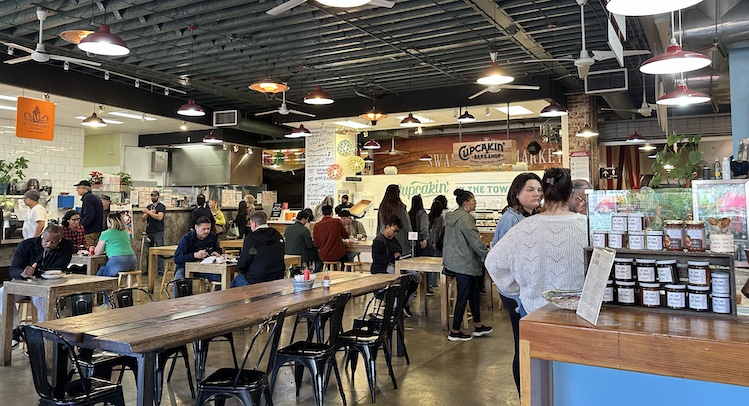
Swan’s Market dining hall is located inside the Old Oakland Farmer’s Market. Food tours stop at Swan’s, but you don’t need a guide to go there. Photo by Marlene Goldman
Black Food Tours focuses on the neighborhood near the Friday Old Oakland Farmer’s Market, where Swan’s Market dining hall is located. The tour stops at T’chaka Haitian restaurant outside Swan’s before heading inside to The Cook and Her Farmer and Cupcakin’ Bake Shop.
One quirky tour option is the self-guided Oakland Cannabis Trail. It winds through various neighborhoods, highlighting places like Uptown’s Root’d in the 510 Equity Weed Dispensary and the Ivy Hill Cannabis dispensary in the 1925 Egyptian-themed Parkway Theater. NUG Oakland, a dispensary and “consumption lounge,” is located in another Cultural Landmark, the former Oaksterdam University.
Talking to local business owners, community, and diversity may be overused buzzwords, but they are also the main reasons they choose to stay. Some are doubling down on their belief in Oakland, such as Paul Iglesias and Sophie Akbar, owners of Colombian restaurant Parche and new Afghani eatery Jaji, representing each of their heritages.
“Oakland, pre-pandemic, was in this upward movement, and then the buzz came to a halt,” says Iglesias, though they stuck with Oakland as their favored location to open three years ago. “There have been challenges, but the community has stood by us since the day we opened our doors.”
Iglesias says they are forming an Oakland restaurant marketing collective to work together as a community. “We believe in Oakland. Come and be a part of our community, and you’re going to see that everyone can thrive.”
Oakland’s longtime attractions are still top draws for visitors, such as the Oakland Museum of California, Oakland Zoo, Children’s Fairyland storybook theme park, which opened in 1948, and the Chabot Space & Science Center, with telescopes open to public viewings. Chabot sits near forested hiking and biking trails.
For a city that has birthed music mega stars from the Pointer Sisters to MC Hammer, music and art also define Oakland. In 2024, Oakland hosted more than 100 events supporting the city’s arts and music scenes. “These types of events not only bring pride to the local community but also impact the economy,” Gamez says.
While the Paramount and nearby Fox Theater draw crowds for live music in the heart of Oakland, smaller clubs such as The New Parish spotlight local artists. Oakland also hosts diverse music festivals like John Waters’ annual Mosswood Meltdown in Mosswood Park, an amalgam of eccentric local bands, old punk rockers and misfits.
Oakland’s First Fridays Art Walk, with the help of the organization Oakland Art Murmur (OAM), breathes life into its Arts District on Broadway and 25th Street. Artists like Elizabeth Sher and Tara Esperanza exhibit at the artist-run Mercury 20 Gallery.
OAM helps organize the annual five-day Oakland Style and East Bay Open Studios, which spans multiple weekends. For Oakland Style, OAM partners its art galleries with up-and-coming fashion designers. “We host tours that showcase these creative partnerships, offering the public an inside look at the intersection of visual art and fashion,” says Ronice Stratton, the new director of OAM.
One way to get a sense of Oakland’s history and local art scene is through its myriad murals. Now, the Laurel District along MacArthur Boulevard from 35th Avenue to High Street offers a self-guided walking tour of its large-scale murals. The Laurel District Association has mounted plaques with detailed information at 10 large pieces along that stretch.
Piedmont Avenue draws foot traffic to a half-mile stretch filled with boutiques, bookstores, nail salons, coffee shops, and Oaklands longest-running cinema, the Piedmont Theatre. Bonnie Lucas, owner of the 30-year-old Black Swan Books, notes that all the stores are independent. Her shop survives by selling other items such as Japanese wood blocks, Kachina dolls, and Native American pottery. One newcomer to the block, Moving Records, is drawing brisk business, leaving owner Justin Briggs optimistic for its future.
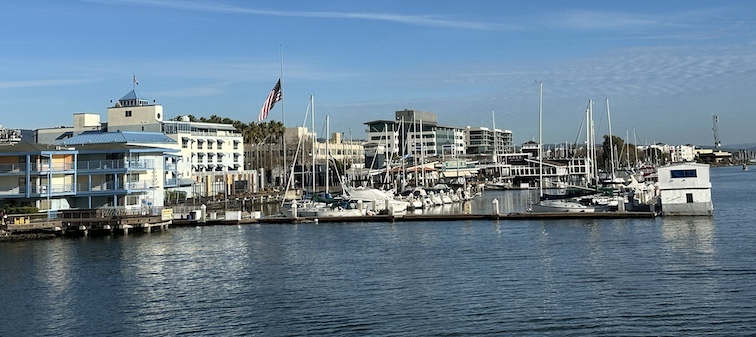
Oakland’s Jack London Square as seen from the ferry arriving from San Francisco. Photo by Marlene Goldman
While Piedmont Avenue on a Friday night is filled with locals, Jack London Square on a recent Sunday afternoon is noticeably quiet. Set along the waterfront and accessible from San Francisco by ferry, Jack London Square is named for the author. Born in San Francisco in 1876, his family moved to Oakland when he was about age 10. London frequented the waterfront, according to Elliott Myles, owner of Heinold’s: First & Last Chance Saloon, which opened in 1884. London befriended the original owner, Johnny Heinold. London gave him a copy of each of his first editions until he died in 1916.
The bar has only been closed three times in its history – once for COVID, another stretch when Heinold had surgery, and the first time, following the 1906 earthquake, which resulted in the bar’s famous slanted floor, which is one reason it’s on the National Register of Historic Places.
“On the back wall we have a monument to the shipyard workers of World War II. We call it the wedge,” says Myles, who started working as a barback at Heinold’s in 1991. The wooden wedge was used because of the slant to make sure they got an exact ounce-and-a-half pour. Outside the bar is a replica of Jack London’s cabin near Dawson City, Alaska, with some original materials.

The bar in Heinold’s First and Last Chance Saloon is tilted, as is the floor. It’s not a good idea to slide an icy beer down the bar or drink too many beers. Photo by Rich Grant
Some longtime restaurants around Jack London Square, like Scott’s Seafood Grill & Bar and nearby Everett & Jones BBQ have endured, but many others closed when the proposed new baseball stadium for the Oakland A’s fell through.
Hal Campos, CEO/General Manager of Yoshi’s nightclub, which opened at the Square in 1997, also blames negative press for the area’s downturn. Yoshi’s, which hosts jazz, blues and more, still sells out early concerts, but attendance for 10 pm shows is down. “All this bad press makes people to think, ‘Do I want to go to Oakland? Do I really want to stay for a 10 pm show?’”
Campos says, “Oakland is such a beautiful city, rich with culture and fashion and food. We have everything here.” He, like other business owners, are hopeful a new administration will focus on cleaning up the city.
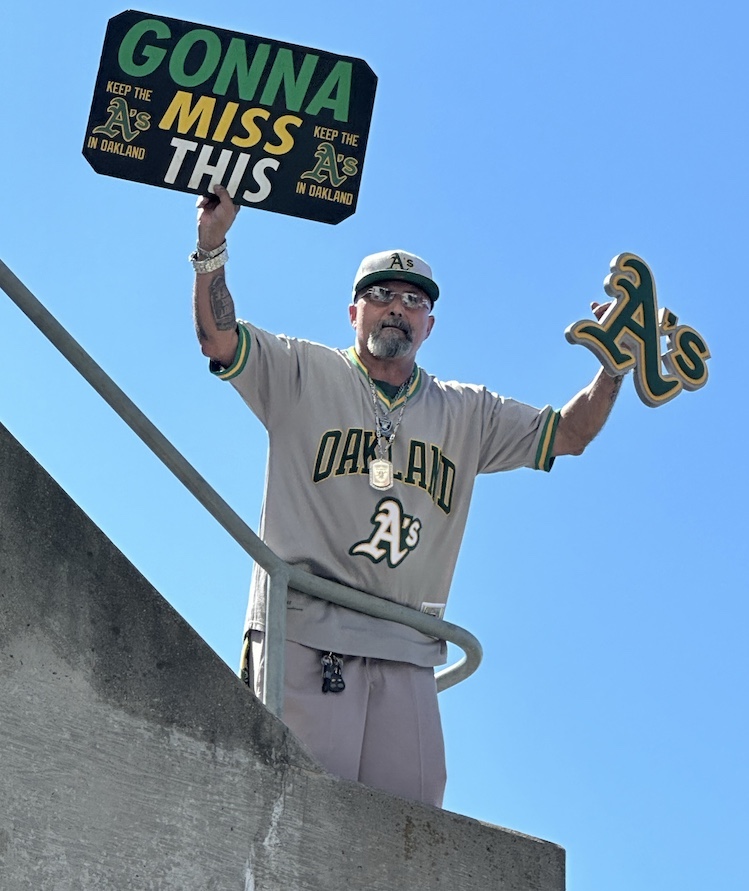
Fans show their affection for Oakland’s Athletics during their final game last September. Losing all of its professional sports teams was a blow from which the city is still recovering. Unsatisfied with the condition of the venue where it played, Oakland’s basketball team moved to San Franscisco in 2019. The following year, the football Raiders left for Las Vegas. Oakland’s baseball franchise, the A’s, spent years seeking financial help to build a new stadium near Jack London Square. But last year, it gave up and followed the Raiders to Las Vegas. Photo by Marlene Goldman.
Bitterness among A’s fans that the city could not negotiate a new location at Jack London Square was evident at last year’s final Oakland A’s home game. Oakland Coliseum was a sea of t-shirts, banners and signs bemoaning the loss of their beloved team.
Baseball fans have a new option in The Oakland Ballers. The B’s in their first season last year, made the playoffs while attracting nearly 100,000 fans to West Oakland’s Raimondi Park, according to Casey Pratt, Ballers’ Vice President of Communications & Fan Entertainment.
“The City of Oakland rallied around the B’s taking an historic park and turning it into a pro baseball stadium,” Pratt says. “All the streets around the ballpark are freshly paved, the neighbors love it, and there’s a spectacular public market going in across the street. It’s a wonderful story of revitalization in West Oakland.”
Oakland’s rebound seems inevitable, according to Dr. Saturu Ned, one of the Black Panther Party alumni tour leaders for Oakland’s Black Panther Party City Legacy Tours. Ned, who at the time was known as James Mott, joined the Black Panther Party in May 1968 and was a teacher at the award-winning Oakland Community School and Learning Center that was started and run by Black Panther Party Members.

Oakland’s African American Museum and Library is located inside the Carnegie Building. The artwork inside the building illustrates the city’s colorful Black history. Photo by Marlene Goldman
His tours stop at historic points in Downtown Oakland, such as the Federal Building and Latham Square Plaza, which is currently home to a bust of Breonna Taylor. Other stops include the African American Museum and Library at Oakland, housed in a Carnegie building. Its upstairs panels detail the city’s Black history.
“Oakland has always been an amazing place,” says Ned. “There’s something about Oakland where the seeds of resistance have never been completely dug up or changed. That’s part of why people look at Oakland. It’s a story of tenacity.”![]()
Marlene Goldman is a San Francisco-based writer focusing on travel and culture. This is her first story for the East-West News Service.

